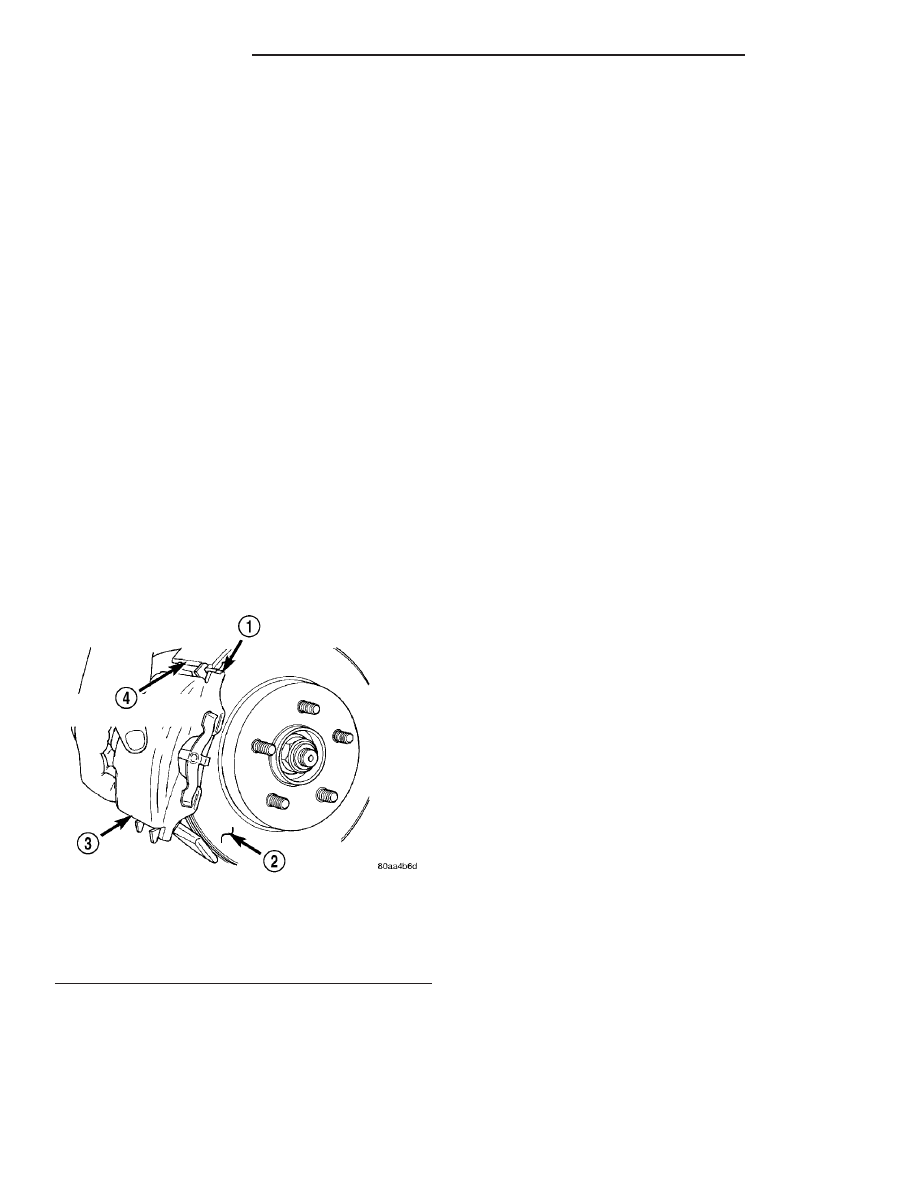Dodge Neon / Neon SRT-4. Manual - part 38

INSTALLATION
NOTE: Step 1 below is only required when installing
a caliper after new brake shoes have been installed.
(1) Completely retract the caliper piston back into
the bore of the caliper.
(2) Lubricate both steering knuckle caliper slide
abutments with a liberal amount of Mopar
t Multi-
purpose Lubricant, or an equivalent.
CAUTION: Use care when installing the caliper
assembly onto the steering knuckle so the seals on
the caliper guide pin bushings do not get damaged
by the steering knuckle bosses.
(3) Install the disc brake caliper (with pads) on the
brake rotor and steering knuckle. The left side cali-
per is installed by first sliding the top of the caliper
past the top caliper slide abutment on the steering
knuckle to hook the top edge of the caliper, then
pushing the lower end of the caliper into place
against the knuckle (Fig. 61). The right side caliper
is installed by first sliding the bottom edge of the cal-
iper past the lower caliper slide abutment on the
steering knuckle to hook the lower edge of the cali-
per, then pushing the top of the caliper into place
against the steering knuckle.
(4) Install the caliper guide pin bolts and tighten
them to a torque of 22 N·m (192 in. lbs.) (Fig. 47).
(5) Install the banjo bolt connecting the brake hose
to the brake caliper (Fig. 46). Install NEW washers
with the banjo bolt. Place one NEW washer on
each side of the hose fitting as the banjo bolt is
guided through the fitting. Thread the banjo bolt into
the caliper and tighten it to a torque of 24 N·m (210
in. lbs.).
(6) Install the tire and wheel assembly(Refer to 22
- TIRES/WHEELS - INSTALLATION). Tighten the
wheel mounting nuts to a torque of 135 N·m (100 ft.
lbs.).
(7) Lower the vehicle.
(8) Remove the brake pedal holding tool.
(9) Bleed the caliper as necessary. (Refer to 5 -
BRAKES - STANDARD PROCEDURE)
(10) Road test the vehicle and make several stops
to wear off any foreign material on the brakes and to
seat the brake pads.
DISC BRAKE CALIPER -
FRONT - SRT-4
REMOVAL
NOTE: Before proceeding, (Refer to 5 - BRAKES -
WARNING)(Refer to 5 - BRAKES - CAUTION).
(1) Using a brake pedal holding tool, depress the
brake pedal past its first one inch of travel and
secure it in this position. This will isolate the master
cylinder from the brake hydraulic system and will
not allow the brake fluid to drain out of the master
cylinder reservoir when the lines are opened.
(2) Raise the vehicle. (Refer to LUBRICATION &
MAINTENANCE/HOISTING - STANDARD PROCE-
DURE)
(3) Remove the front tire and wheel assembly.
(4) Remove the banjo bolt connecting the brake
hose to the brake caliper (Fig. 62). There are two
washers (one on each side of the flex hose fitting)
that will come off with the banjo bolt. Discard the
washers.
(5) Remove the two brake caliper guide pin bolts
(Fig. 62).
(6) Remove the disc brake caliper from the disc
brake adapter.
DISASSEMBLY
NOTE: Before disassembling the brake caliper,
remove it from the vehicle. (Refer to 5 - BRAKES/
HYDRAULIC/MECHANICAL/DISC BRAKE CALIPER -
REMOVAL)
NOTE: Before disassembling the brake caliper,
clean and inspect it. (Refer to 5 - BRAKES/HY-
DRAULIC/MECHANICAL/DISC BRAKE CALIPER -
CLEANING)(Refer to 5 - BRAKES/HYDRAULIC/ME-
CHANICAL/DISC BRAKE CALIPER - INSPECTION)
Fig. 61 Installing Left Caliper
1 - SLIDE TOP OF BRAKE CALIPER UNDER TOP ABUTMENT OF
STEERING KNUCKLE AS SHOWN
2 - BRAKING DISC
3 - DISC BRAKE CALIPER
4 - STEERING KNUCKLE BRAKE ABUTMENT
5 - 34
BRAKES - BASE
PL/SRT-4
DISC BRAKE CALIPER - FRONT (Continued)